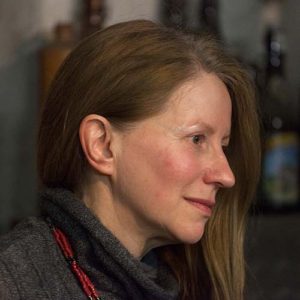Born 1957 in Belluno, Italy. Attended the „School of fine Arts“ in Addis Abeba, Ethiopia, private tuition/workshops with renowned artists: Barbara Tesfaye-Parker, (Poland) and Sylvie Le Seach, (France) 1993 to 1996. From 1996 onwards art classes under the guidance of photographer and visual artist Michael Gnade at the college of further education, specialising in life and portrait drawing. During those years his studio becomes her second ‘home’ and a fruitful collaboration arises leading to diverse artistic and literary projects. Since 2005 teaching of drawing and painting workshops at the adult education centre and in her own studio.
By Michael Gnade (visual artist and Photographer) – For me, as an artist, it is a great pleasure to know Dina Savi. She is a kindred spirit and a cosmopolitan by biography: born in Belluno/Italy 1957 and grown up in Switzerland (1965-75), pursuing professional interests in London and Cologne (1976-88); living in Baghdad/Irak and experiencing Addis Abeba/Ethiopia (1989-96) before settling in Bensberg.
Much could be said about her life-odyssey and moreover about her development as an artist across continents. At this point I wish to comment on her nude drawings as in contemplation I am reminded of the forms of great style in Titian’s Venice, Raphael’s Rome and Florence. They are witnesses of gracefulness in the realm of beauty up to Giacomo Manzù in our times!
For us, the northern artists, from Dürer, to Hans von Marées and Anselm Feuerbach, we owe a great debt of gratitude to the Italians for the premonition of what sculptural form is concerned with – it is an enthusiasm for beauty. For the French painter Eugène Delacroix, a picture had to be, above all, a feast for the eyes. As for Plato goodness, truth and validity were only conceivable through the medium of beauty. Indeed, the adjective beautiful meaning ‘attractive to the eye’, is a composite of the verbs ‘to look’ and ‘to regard’. Unlike ‘seeing’, the action of looking (or observing) describes an intentional manner of close examination and in an elevated sense, represents an inner, spiritual visualization. This is contemplation – from the Latin vita contemplative and is the life of the true mystic.
In fact Dina Savi is blessed with the skill of immersive observation in front of the subject. “Sur le motif”, the Cezanne formula, is valid for everyone who is inspired by ‘the language and call’ of a subject’s expression which is blissful to behold. When a fine artist surrounds us with the reverberation of these timeless values – which were created in an epoch whose works prompted Rainer Maria Rilke to describe as doing without image’ – we must graciously offer our gratitude.
Furthermore to my eyes, Dina is an attractive woman who works in an instinctively determined and independent manner with distinct intent. Is there something strange about this? The longing for beauty is often compensator for artists disadvantaged by nature. Yet Leonardo was beautiful and did not create ugly pictures. For some, talent is transmitted by the beauty of their soul and is not deficient in spirit or common sense.
I most sincerely hope that these introductory words may serve as stimuli to visit the original works.
Old masters against avant-garde – by Gisbert Franken
Neither the abstract avant-gardist in the Zanders Villa nor the activists invited by the AdK (art working group) following the keywords “città aperta” (open town) to artistically enrich the city of Bergisch Gladbach can be subsumed by the concept defining the perfection of the old masters. Contemporary art is art in an open universe, open to an endless amount of ever new approaches, fragmentary by definition. But it still exists, the aesthetic of the ideal: Dina Savi, born 1957 in Belluno, Italy, and resident in Bergisch Gladbach since 1996 is one of its representatives.
Her artwork, preferably in coal and chalks, breathes the spirit of the renaissance. The temple of beauty it the human body, the measure of all things upon which perception and the aesthetic sense – not only for the Renaissance man – are oriented. Besides nudes and human studies the artist presents still lives in an earthily-rural coloured palette. She employs an oil on chalk-primed papers technique as an approach to a world which is composed of elementary aspects of enjoyment – the mesmerizing spell of a sensuality that has already lured many a stressed esthete from gray-walled cities to the Tuscan hills.
The images exude an air of pensiveness – by Norbert Völl
Unpretentious, apparently easily dashed portraits and nudes alternate with lavishly composed still lives and draperies. The object and the immersion in it are perceptible in every picture. “The pictures exude an air of pensiveness”, highlights Ursula Henze in her welcoming speech on the occasion of a vernissage. They offer calmness and tranquility in comparison to the agitated contemporary art establishment’s market. In place of clamorous experiments, one can find manifested here a close attention to the essence: few objects, a subdued colorfulness and time after time the human body or face appears. The pictures do not convey the hard work that was involved in the creation of them.
Beyond rambunctiousness and the culture of consumption – by Thomas Rausch
Italian influence is perceptible in the works of Dina Savi. Her portraits and nudes strive to capture the personality of her various models. “This is about truthfulness,” Savi comments about her presentation of nudes and human studies. Her works are beyond rambunctiousness and the culture of consumption.
An excerpt from an interview with Angela Sinesi in “Corriere d’Italia”:
Corriere: Do you still feel Italian after spending so many years in foreign countries and having abandoned Italy as a child?
Savi: Yes, perhaps I feel even more Italian in many respects, as if I had constantly lived in my home country. Besides, leading this ample kind of life made me aware that I should find a new homeland within myself. The nature of endeavour within the arts was indispensable to me.
